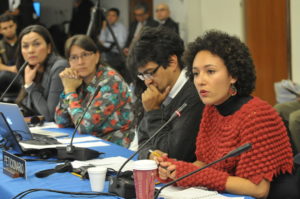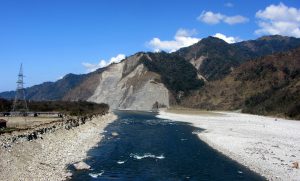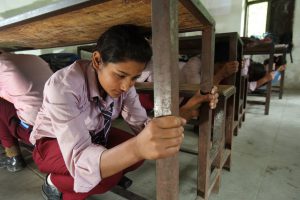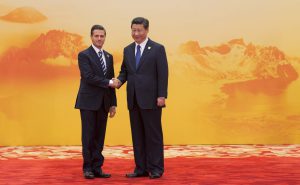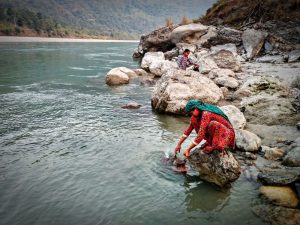South Asia remains one of the least connected regions of the world, because of lack of infrastructure and deep political mistrust between countries. But in recent years a push to boost trade along the vast network of inland waterways of Bangladesh, Bhutan, India and Nepal (known as the BBIN sub region) has gathered strength.
A new study from CUTS International – “Expanding Tradable Benefits of Trans-boundary Water: Promoting Navigational Usage of Inland Waterways in Ganga and Brahmaputra Basins” – produced with support from The Asia Foundation, identifies some of the challenges for policymakers trying to realise these opportunities, and for communities living along the riverbanks.
Read Also: Water based transport: perils and possibilities
The transboundary river basins of the Ganga-Brahmaputra support the life and livelihoods of over 600 million people. Any changes to the river and its water flow from growing shipping and navigation will affect the livelihoods of the nearly 1.3 million farming households and tens of thousands of fishing households dependent on the rivers.
The development of inland waterways could create a cheaper and more environmentally friendly way to shuttle people and goods between countries and boost economic opportunities for communities living along the banks, in terms of boat making industry, fright handling, tourism etc.
However, if not properly regulated, the growth of this transport system will work against the interests of local communities and the environment in all four countries, concludes the report published in January. Environmental concerns like damage to fish and dolphin sanctuaries due to dredging, river water pollution due to oil spillage and waste disposal also pose real challenges in Bangladesh and India.
Read also: Will waterways succeed where motorways have not
Riding the wave
Historically, the waterways of the Ganga and Brahmaputra were central to a flourishing trade in South Asia. Under British colonial rule rivers were neglected in favour of railways and then road and later new political boundaries stymied cross border trade.
Though water is the major means of transport in Bangladesh, its scope is still hugely limited in India. With proper infrastructure land locked countries like Bhutan and Nepal could also benefit from the development of inland navigation in India and Bangladesh.
Momentum is now gathering again – and a series of bilateral and multilateral agreements have been signed in recent years. In 2015, Bangladesh and India signed a Protocol on Inland Water Trade and Transit (PIWTT), providing an opportunity for both countries to explore investment on the routes designated. This built on an existing protocol signed in 1972 through which Bangladesh allowed Indian ships to ply between West Bengal and Assam. In 2016, Bangladesh and India signed another Memorandum of Understating (MoU) to allow tourists from Bangladesh and India to use coastal and protocol routes between countries.
Bangladesh and India are currently working together and investing on infrastructure and maintenance to keep their protocol routes navigable throughout the year for cargo ships of no less than 2,000 tonnes capacity. Land-locked Bhutan also signed an MoU with Bangladesh in 2017 to use Bangladesh’s inland waterways for transportation of goods and services through Chittagong and Mongla ports for both imports and exports.
While these new agreements are welcome, the report collates concerns of local people in all four countries that developing river navigation will create major threats to river ecosystems and marginalised communities.
The authors of the report found that environmental concerns were raised in all four countries – especially in Bangladesh and India – about the risk of accidents, oil spills, waste discharge, turbidity changes and loss of spawning grounds for aquatic life with greater movement of vessels and further waterway developments. There were also many concerns about the effects of dredging, which is a must for navigation through the silt-laden rivers.
“Cumulative impact of these is also a recipe for disaster to the local communities living around the rivers, specifically the fishermen and agrarian communities that depend on the riverbeds for their overall sustenance,” warns the report.
Some of the key concerns highlighted:
- Maintaining waterways involves continuous dredging, sand mining, and other construction works, which can potentially have adverse effects on the biodiversity of the riverine ecosystem. This might create stress on the ecosystem, with potential for conflicts with local communities engaged in fishing and other livelihood activities.
- More river traffic means greater risk of accidents, oil spills, river pollution and loss of fish spawning grounds.
- Growing river traffic may threaten Hilsa sanctuaries unless adequate precaution is taken to prevent the damage from ships. There are five Hilsa fish sanctuaries on the protocol routes 1 and 2. Hilsa is a national fish of Bangladesh and a source of income for a majority of the fishing folks living in the coastal areas.
- The turtle sanctuary at Varanasi, Uttar Pradesh and the Vikramshila Dolphin Sanctuary at Bhagalpur, Bihar fall within Ganga’s National Waterway-1 in India; environmentalists have objected to vessel movement and dredging in these stretches.
- In both Bangladesh and India, river routes are increasingly in use for transporting bulky products like coal, fly ash, stones, sand, minerals, construction materials etc., all with potential adverse effects of the ecosystem in case of vessel capsize and spillage.
- Expansion of cross-border water transportation might damage the quality of water if these vessels and/or upstream communities are not regulated to prevent throwing of garbage, oil, and other pollutants in the rivers. River water contains minerals which are used by local communities for healing purposes. Pollutants often get deposited at the bottom of the river which is habitat of several types of fish (like cat fish). Reduction of fish in the river system will threaten livelihood of many people.
- River routes are squeezed by the road networks as it expands, with construction of bridges and culverts on rivers and channels. Rivers get encroached and filled with garbage. Riverbanks are often used as open storage sites for sand, stone, bamboo etc. Local boat people already find it increasingly difficult to support their livelihood. In several countries, governments have developed necessary regulatory frameworks to ensure that construction of roads does not constrain movement on rivers. Such a framework allows waterways and motorways to become complementary rather than substitutes.
Concerns for women
- Communities living on the bank of rivers use river water for bathing and washing. Increased navigation will increase risk of harassment for women unless regulatory oversight is strengthened.
- Women engaged in local businesses and petty trade will find their livelihoods under threat due to rapid changes in the overall economic activities in the area. As communities get linked with nearby river ports, women will find it difficult to switch to new jobs because many of them are illiterate or have very low levels of literacy.
Key recommendations
The report identifies key recommendations for policymakers to protect local communities and ecosystems while promoting river transport:
- Development of inland waterways for navigation using an integrated strategy with active participation of BBIN countries;
- Development of a protocol for movement of ships carrying goods on specified protocol routes keeping in view fish sanctuaries, ecologically sensitive areas, bio-reserves and community use of rivers for livelihoods;
- Development of protocol for moving tourists across boundaries and engaging local communities for cultural and nature-based tourism;
- Fostering ports of call that are service-friendly for seamless transfer of goods from one mode to another, like on to road and/or rail;
- Development of protocol for disposal of wastes from ships and boats to reduce environmental impacts;
- Modification of customs and immigration protocols to promote navigational use of rivers across borders;
- Synchronisation of dredging activities across borders and establishment of joint commission between countries sharing the same river;
- Allowing licensed small and mechanised boats to transport goods for short distances across borders to promote local trade across borders;
- Recognising conventional rights of the riverine people while developing protocols for cross-border navigational use of inland waterways to avoid alienation of the local marginalised communities; and
- Framing strategies for localised river-dependent communities by engaging them in river training, disaster management, freight handling and other services that will supplement their incomes.
![<p>Freight transport on the Brahmaputra, at Hatsinghimari, Assam [Image: Veena Vidyadharan]</p>](https://dialogue.earth/content/uploads/2018/02/Inland_Water_Transport_Hatsinghimari_Assam_Image_Veena_Vidyadharan.jpg)


